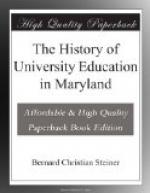Misfortunes never come singly: an unsuccessful attempt to burn the buildings had been made in the fall of 1788, and now, on December 4, 1795, a completely successful one was made, and the building and its contents were consumed. Rewards to discover the incendiary were offered in vain, and Asbury writes:[38] “We have a second and confirmed report that Cokesbury College is consumed to ashes—a sacrifice of L10,000 in about ten years. If any man should give me L10,000 to do and suffer again what I have done for that house, I would not do it. The Lord called not Mr. Whitefield, nor the Methodists to build colleges. I wished only for schools; Dr. Coke wanted a college. I feel distressed at the loss of the library.”
Asbury despaired, but Coke did not and, going to work, he raised L1,020 from his friends. After the determination was made to move the College to Baltimore, the Church there gave L700, and a house to house solicitation brought in L600 more. A building originally erected for balls and assemblies was purchased and fitted up. It stood next the old Light Street Methodist Church and a co-educational school was opened therein on May 2, 1796. The high course planned for girls is especially noticeable at this early period. The school opened with promises of success, and within a month there were nearly 200 scholars.
Fatality pursued the enterprise, however, and a year to a day from the burning of the first building, this second one was reduced to ashes, with the adjoining church and several houses.
Asbury writes rather philosophically:[39] “I conclude God loveth the people of Baltimore, and he will keep them poor to make them pure;” but even Coke gave up hope at this new disaster, and it was twenty years before a second Methodist College was attempted.
ASBURY COLLEGE.
This was the second Methodist College in the world, and was organized in 1816, the year of Bishop Asbury’s death. After a year or two of successful work, a charter was applied for and it was granted to the College February 10, 1818.[40] The President, Samuel K. Jennings, M.D., a Methodist local preacher, was a rather remarkable man. Coming from New Jersey, graduating at Rutgers, and settling in the practice of the medical profession in Virginia, he was converted by the preaching of Asbury, and was persuaded by him some years later, to move to Baltimore and take the leadership of the new enterprise.[41] He was said to be, at one time, the only Methodist preacher with a collegiate education and was well adapted to the task, from his administrative ability and wide learning. Around him, he gathered an undenominational faculty of four professors and began the life of the institution in a large brick building on the corner of Park Avenue and Franklin Street. In March, 1818, the Methodist Magazine tells us that there were one hundred and seventy students, and that “The Asbury College has probably exceeded in its progress, considering




